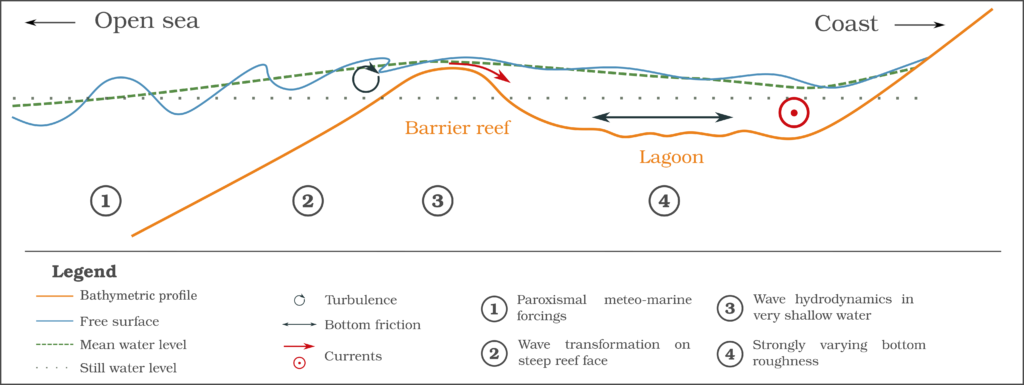Hydrodynamic resilience of reef-lagoon systems: a quantitative approach applied to the island of Maupiti (French Polynesia)
Laboratory:
Field:
Directors:
Key Words:
Géosciences Montpellier
Coastal Hydrodynamics
Frédéric Bouchette, Damien Sous
Resilience, Lagoon Hydrodynamics, Waves, Numerical Modelling.
My thesis work is made possible thanks to the research activities of the GLADYS group on the island of Maupiti, in particular the measurement campaign Maupiti Hoé 2018 and the numerical modelling SWAN-Delft3D of the island.
Introduction
When a reef surrounds and isolates a body of water, this body of water is called a lagoon. The energy transfers applied to waves and currents during the passage over the reef are both very complex and crucial to characterize the dynamics inside the lagoon. The physics at work can be summarized from the point of view of wave propagation. Swells generated offshore propagate towards the reef. Before arriving at the reef, these swells undergo multiple changes: wind-driven growth, non-linear frequency transfers. Arriving at intermediate depths, the swell interacts with the bottom, is oriented towards the shallow water, slows down and get bigger. Now in shallow water, the swell reaches its maximum size. Due to the geometry, roughness and porosity of the reef, some of the energy is reflected and some is dissipated locally by breaking, turbulence or friction. Part of the energy carried by this swell is transformed into a local augmentation of water level, the water level differences produce currents and these currents are slowed down by the roughness of the bottom. After these transformations, the remaining swell is finally propagated inside the lagoon.

Coral reefs are being degraded by anthropogenic pressures and changes in climate and ocean conditions. The protection of the shores and ecosystems sheltered by these reefs depends on numerous hydrodynamic, sedimentary and biological couplings for which a detailed knowledge is necessary.
Objectives
My thesis aims to describe the hydrodynamics of reef lagoon systems and their tendency to maintain specific hydrodynamic properties when subject to variations in various forcings (geometrical changes of the reef island, extreme meteo-marine forcings, bottom friction variations). Since lagoons are very diverse and always fluctuating, the most effective way to study the impact of global change is to define and measure the resilience of the systems at the island scale.
